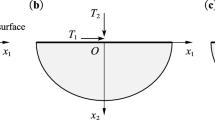Abstract
In this paper a comprehensive investigation is carried out with regard to the state of the stress and strain in the neighbourhood of notches in bodies subjected to an anti-plane state of shear stress, within the context of a strain limiting theory of elasticity. Taking advantage of a unified analytical framework, the strain-limiting theory of elasticity is used to determine the full stress and strain field close to a pointed or radiused notch with any notch opening angle. An extensive discussion is provided that highlights the main features of stress and strain distributions, and the implications of the new theory for fracture assessments. In particular, it is proved that the obtained stress and strain solution predicts finite strains at the notch tip and allows the intensity of the stress field to be written as a function of the elastic Notch Stress Intensity Factor \(K_{3}\), as in the case of conventional linearized elasticity theory. This makes the strain limiting elasticity an excellent vehicle for justifying theoretically a K based-approach to the fracture of brittle elastic solids, within the context of a self consistent theory, unlike the classical linearized theory that predicts singularities for the strain at crack tips.












Similar content being viewed by others
References
Abramowitz M, Stegun IH (1972) Handbook of mathematical functions. Dover Publications, USA
Arfken GB, Weber HJ (2001) Mathematical methods for physicists. Academic Press, San Diego
Broberg KB (1999) Cracks and fracture. Academic Press, San Diego
Bulicek M, Malek J, Rajagopal KR, Suli E (2015a) On elastic solids with limiting small strain: modelling and analysis, In Press, EMS Surveys
Bulicek M, Malek J, Rajagopal KR, Walton J (2015b) Existence of solutions for the anti-plane stress for a new class of “strain-limiting” elastic bodies. Submitted for publication in Calc. Var. and PDE
Bustamante R, Rajagopal KR (2010) A note on plane strain and plane stress problems for a new class of elastic bodies. Math Mech Solids 15(2):229–238
Bustamante R, Rajagopal KR (2011) Solutions of some simple boundary value problems within the context of a new class of elastic materials. Int J non-linear mech 46:376–386
Cherepanov GP (1998) Fracture. Krieger Publishing Company, Malabar
Filippi S, Lazzarin P, Tovo R (2002) Developments of some explicit formulas useful to describe elastic stress fields ahead of notches in plates. Int J Solids Struct 39:4543–4565
Gou K, Mallikarjuna M, Rajagopal KR, Walton JR (2015) Modeling fracture in the context of a strain-limiting theory of elasticity: A single plane-strain crack. Int J Eng Sci. In press
Hildebrand FB (1976) Advanced calculus for applications. Prentice Hall, USA
Hult JAH, McClintock FA (1956) Elastic-plastic stress and strain distribution around sharp notches under repeated shear. In: 9th Int Cong Appl Mech, 8, Brussels
Kaninnen MF, Popelar CH (1985) Advanced fracture mechanics. Oxford University Press, New York
Knowles JK, Sternberg E (1983) Large deformation near a tip of an interface-crack between two neo-hookean sheets. J Elast 13:257–293
Kulvait V, Málek J, Rajagopal KR (2013) Anti-plane stress state of a plate with a V-notch for a new class of elastic solids. Int J Fract 179:59–73
Lazzarin P, Zappalorto M (2008) Plastic notch stress intensity factors for pointed V-notches under antiplane shear loading. Int J Fract 152:1–25
Neuber H (1958) Theory of notch stresses. Splinger-Verlag, Berlin
Neuber H (1961) Theory of stress concentration for shear-strained prismatical bodies with arbitrary nonlinear stress-strain law. J Appl Mech 28:544–550
Neuber H (1968) A physically nonlinear notch and crack model. J Mech Phys Solids 16:289–294
Ortiz A, Bustamante R, Rajagopal K (2012) A numerical study of a plate with a hole for a new class of elastic bodies. Acta Mechanica 223(9):1971–1981
Rajagopal KR (2003) On implicit constitutive theories. Applic Math 48:279–319
Rajagopal KR (2007) The elasticity of elasticity. Zeitschrift frangewandte Mathematik und Physik 58(2):309–317
Rajagopal KR (2011a) On a new class of models in elasticity. J Math Comp Appl 15:506–528
Rajagopal KR (2011b) Conspectus of concepts of elasticity. Math Mech Solids 16(5):536–562
Rajagopal KR (2011c) Non-linear elastic bodies exhibiting limiting small strain. Math Mech Solids 16:122–139
Rajagopal KR, Walton JR (2011) Modeling fracture in the context of a strain-limiting theory of elasticity: a single anti-plane shear crack. Int J Fract 169:39–48
Rajagopal KR, Srinivasa AR (2007) On the response of non-dissipative solids. Proc R Soc Lond Ser A Math Phys Eng Sci 463(2078):357–367
Rajagopal KR, Srinivasa AR (2009) On a class of non-dissipative materials that are not hyperelastic. Proc. R. Soc. Lond Ser A Math Phys Eng Sci 465:493–500
Wang TJ, Kuang ZB (1999) Higher order asymptotic solutions of V-notch tip fields for damaged nonlinear materials under antiplane shear loading. Int J Fract 96:303–329
Zappalorto M, Lazzarin P (2009) A new version of the Neuber rule accounting for the influence of the notch opening angle for out-of-plane shear loads. Int J Solids Struct 46:1901–1910
Zappalorto M, Lazzarin P (2010) A unified approach to the analysis of nonlinear stress and strain fields ahead of mode III-loaded notches and cracks. Int J Solids Struct 47:851–864
Zappalorto M, Lazzarin P (2011) Stress fields due to inclined notches and shoulder fillets in shafts under torsion. J Strain Anal Eng Des 46:187–199
Zappalorto M, Lazzarin P, Filippi S (2010) Stress field equations for U and blunt V-shaped notches in axisymmetric shafts under torsion. Int J Fract 164:253–269
Zappalorto M, Berto F, Lazzarin P (2011) Practical expressions for the notch stress concentration factors of round bars under torsion. Int J Fatigue 33:382–395
Zappalorto M, Lazzarin P, Berto F (2014) Averaged strain energy density and J-integral for U- and blunt V-shaped notches under torsion. Int J Fract 188:173–186
Author information
Authors and Affiliations
Corresponding author
Rights and permissions
About this article
Cite this article
Zappalorto, M., Berto, F. & Rajagopal, K.R. On the anti-plane state of stress near pointed or sharply radiused notches in strain limiting elastic materials: closed form solution and implications for fracture assessements. Int J Fract 199, 169–184 (2016). https://doi.org/10.1007/s10704-016-0102-1
Received:
Accepted:
Published:
Issue Date:
DOI: https://doi.org/10.1007/s10704-016-0102-1




